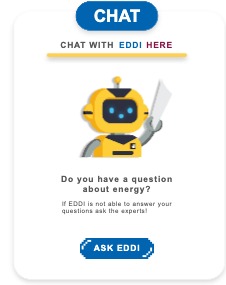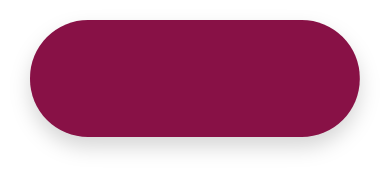



ASK EDDI


CHAT


CHAT WITH
EDDI
HERE
Do you have a question
about energy?
If EDDI is not able to answer your
questions ask the experts!



ASK


ASK AN
EXPERT
HERE

CLICK ON A QUESTION BELOW TO SEE THE ANSWER
Answer: The situation that you are asking about is quite rare, Diego! Power lines are firmly connected to the utility poles that support them and are unlikely to fall directly on top of people. It takes a very strong wind and/or serious damage to a utility pole to knock a power line down. (That’s why you should always be alert for fallen power lines during and after windstorms.) You should never approach or touch anyone or anything in contact with a downed power line. Call 911.
In the unlikely event that a power line comes down on or near you, you should shuffle far away from the line with small steps, always keeping your feet close together and on the ground. Warn other people to stay away from the line and ask them to call 911 and the local electric utility for help.
nt Goes Here
Answer: Carbon is a chemical element with the symbol C and atomic number 6. It is the second most abundant element in the human body. Every single organic molecule in your body contains carbon. It is the basis of life and energy itself.
All plants and living creatures are formed by organic compounds where carbon is combined with hydrogen, nitrogen, oxygen and other elements.
Carbon makes up about 0.025 percent of the Earth’s crust. Carbon is also in the sun, stars, comets and the atmospheres of most planets.
Carbon moves from place to place as part of the carbon cycle. For instance, when we breathe, we exhale carbon dioxide. Plants take in that carbon dioxide to grow, which removes it from the atmosphere. A balance of carbon in the atmosphere is needed to have a hospitable living environment on Earth.
When plants and animals die and decompose, sediment containing carbon is formed. Some of this sediment becomes fossil fuels, such as coal, oil or natural gas. When fossil fuels are burned, they release carbon-emitting greenhouse gases into the atmosphere. According to scientists, the burning of fossil fuels is upsetting the atmosphere’s carbon balance, leading to extreme weather and climate change.
Answer: I, the Expert, am not an AI bot! I am a real person named Reece who swims, rides a bike, and dances. And for even more fun I answer your questions, as I love science education and care about energy safety!
Answer: There are many forms of energy, Hailey, but since you’re asking me, the SCE Expert, I will answer for one form of energy: electricity. Most electricity used in the United States is produced at power plants or at solar and wind farms, and to get to your home, it must travel a great distance over high-power transmission lines. Electricity loses some of its strength (voltage) as it travels, so transformers, which boost or “step up” its power, must help it along. Different kinds of transformers at utility substations will then “step down” electricity’s power to just the right voltage for the overhead or underground distribution wires that bring it to your neighborhood.
Answer: Water and certain chemicals can conduct current from electrical equipment, creating a shock and fire hazard. Keeping electrical equipment dry and clean helps it run safely.
Answer: Many of our daily activities require electricity, such as lighting our homes; cooking with a toaster oven, range, or microwave; keeping food cold with a refrigerator; washing clothes; using a computer; watching TV; and charging our devices. Electricity powers our modern lives!
Answer: Ella had this same question, and I will answer it again for you. Yes, the human body is a good conductor of electricity! This is because the body is 60-70% water, and water is an excellent conductor. Since the water in our bodies can help electricity flow through us, we need to be extremely careful to not contact electricity.
Answer: Multiple people have contributed to the discovery of electricity in modern times, starting with Englishman William Gilbert in 1600 AD, who gave the Latin term electricus to the electric effect of amber. This term was derived from the ancient Greek word for amber, which was elektron. The word electricity itself first appeared in print in a book written by Sir Thomas Browne in 1646. In the 18th century, Benjamin Franklin performed many experiments to learn more about electricity and its connection to lightning. Finally, in 1800, Allesandro Volta created one of the first electric batteries!
Answer: A good question, and you’re not the first person to ask it! Most electricity in this country is made (or produced) at power plants where fossil fuels (coal, oil, natural gas) or renewable energy sources (such as water, wind, biomass, or geothermal) are used to turn turbines. The turbines turn electromagnets that are surrounded by heavy coils of copper wire. The moving magnets cause the electrons in the copper wire to move from atom to atom, generating electricity. Electricity can also be produced from sunshine, using special panels that convert sunlight into electricity. You can see these panels on the rooftops of many Southern California homes, businesses, and warehouses.
Answer: If you step in a puddle that contains a fallen power line, you could be badly injured or even killed! Downed power lines can electrify puddles, wet grass and the surrounding area. Be especially alert for power lines in puddles after stormy weather, and NEVER touch anyone or anything in contact with a downed line. Stay far away and call 911.
Answer: I have never seen a balloon with hair, but I can tell you that releasing any balloon near power lines is definitely a bad idea! A balloon that gets stuck in power lines can cause a power outage or fire, and can also pose a shock hazard to someone who tries to grab its string. Always keep balloons, kites and flying toys far away from power lines.
Answer: Lightning travels at a speed of 220,000 miles per hour, so if you can’t beat that, then unfortunately, you can’t outrun lightning. Lightning can be deadly. Reduce the chances of being struck while indoors by not touching windows, plumbing, metal objects, or electronics during a lightning storm. If you’re outside, get indoors when a storm is approaching. Read about what to do if you can’t get to shelter on our website here. And read about one lucky lightning shock survivor’s tale on our website here.
Answer: Plastic does indeed help prevent electric shocks. For example, on our home appliances and power cords, special insulating plastic keeps us from contacting the electricity inside. If this plastic becomes damaged in any way, you risk coming in contact with a bare electrical wire, which could cause shock and injury. That’s why you should always report a damaged cord or appliance to an adult.
Answer: It takes a LOT of watts to power a factory! Electricity use for factories is measured in megawatts, which are units of one million watts. An integrated cement plant can use 650 megawatts. Other types of factories may use much more electricity or much less, depending on their size, production load, and other factors.
Answer: Locked-in syndrome is a rare neurological disorder characterized by complete paralysis of voluntary muscles, except for those that control the eyes. It may be caused by a spinal cord injury, a stroke or another serious condition that can lock people in their bodies. Their brains still produce electrical signals when stimulated. They are alert, intelligent, have memory and can learn, but since their nervous systems are badly damaged, electrical signals cannot reach their muscles. They can’t move their arms or legs or even speak. People with this “locked-in syndrome” have great difficulty communicating with others.
Answer: Electricity is a form of energy that begins with atoms. Atoms are tiny particles that comprise everything around us. The center of the atom has at least one proton and one neutron. At least one electron travels around the center of the atom at a very great speed. An outside force, called voltage, can push electrons from atom to atom. This movement of electrons produces electricity.
Answer: If you touch someone who is in contact with an electricity source, electricity will travel through you as well. You could be seriously injured or even killed! Do NOT touch the person or anything he or she is touching. Instead, stay far away, tell an adult to turn off the power at the fuse box or circuit breaker, and call 911 for help.
Answer: Small birds can sit safely on one power line and not get shocked because the electricity is always looking for a way to get to the ground. If the birds are not touching the ground or anything in contact with the ground, electricity will stay in the power line and won’t harm the birds. However, birds with broad wingspans are more likely to touch a power line and pole at the same time, which can create a path for electricity to travel down the pole to the ground. Their large wings can also bridge two power lines, creating a circuit or a path for electricity. In either situation, the birds can be electrocuted.
Answer: Yes, the human body is a good conductor of electricity because it is 60-70% water. This means that if you touch electricity, electricity will flow through you, and you will be badly hurt.
Answer: Many of our daily activities require electricity, such as lighting our homes; cooking with a toaster oven, range, or microwave; keeping food cold with a refrigerator; washing clothes; using a computer; watching TV; and charging our devices. Electricity powers our modern lives!
Answer: A good question, and you’re not the first person to ask it! Most electricity in this country is made (or produced) at power plants where fossil fuels (coal, oil, natural gas) or renewable energy sources (such as water, wind, biomass, or geothermal) are used to turn turbines. The turbines turn electromagnets that are surrounded by heavy coils of copper wire. The moving magnets cause the electrons in the copper wire to move from atom to atom, generating electricity. Electricity can also be produced from sunshine, using special panels that convert sunlight into electricity. You can see these panels on the rooftops of many Southern California homes, businesses, and warehouses.
Answer: Lightning travels at a speed of 220,000 miles per hour, so if you can’t beat that, then unfortunately, you can’t outrun lightning. Lightning can be deadly. Reduce the chances of being struck while indoors by not touching windows, plumbing, metal objects, or electronics during a lightning storm. If you’re outside, get indoors when a storm is approaching. Read about what to do if you can’t get to shelter on our website here. And read about one lucky lightning shock survivor’s tale on our website here.
Answer: It takes a LOT of watts to power a factory! Electricity use for factories is measured in megawatts, which are units of one million watts. An integrated cement plant can use 650 megawatts. Other types of factories may use much more electricity or much less, depending on their size, production load, and other factors.
Answer: Plastic does indeed help prevent electric shocks. For example, on our home appliances and power cords, special insulating plastic keeps us from contacting the electricity inside. If this plastic becomes damaged in any way, you risk coming in contact with a bare electrical wire, which could cause shock and injury. That’s why you should always report a damaged cord or appliance to an adult.
Answer: A magnet generates a magnetic field around itself because of the way atoms are arranged. An electromagnet only generates a magnetic field when an electric current is passing through it.
Answer: There are advantages and disadvantages of placing power lines underground. While low-voltage lines are sometimes placed underground in newer neighborhoods, it is not the preferred method for power lines that carry electric power over long distances. Please see our series of Q&A’s on the subject of overhead vs. underground click here for more specific information.
Answer: Very fast! If you could travel through wires as fast as electricity does–about 300,000 km per second–you could go around the world eight times in the time it takes to turn on a light switch.
Answer: Maddi asked this question just recently, but I’ll repeat my answer for you here. Most electricity in this country is produced at power plants where fossil fuels (coal, oil, natural gas) or renewable energy sources (such as water, wind, biomass, or geothermal) are used to turn turbines. The turbines turn electromagnets that are surrounded by heavy coils of copper wire. The moving magnets cause the electrons in the copper wire to move from atom to atom, generating electricity. Electricity can also be produced from sunshine, using special panels that convert sunlight into electricity. You can see these panels on the rooftops of many Southern California homes, businesses, and warehouses.
Answer: Most electricity in this country is produced at power plants where fossil fuels (coal, oil, or natural gas) or renewable sources (such as water, wind, biomass, or geothermal energy) are used to turn turbines. The turbines turn electromagnets that are surrounded by heavy coils of copper wire. The moving magnets cause the electrons in the copper wire to move from atom to atom, generating electricity. Electricity can also be produced from sunshine, using special panels that convert sunlight into electricity. You can see these panels on the rooftops of many Southern California homes, businesses, and warehouses.
Answer: Here is a simple example of energy conversion: When you boil water using an electric teapot, electrical energy is converted to thermal energy, or heat. Energy conversion also occurs within your body, as your digestive process converts the chemical energy of food to the mechanical energy that you use to move and the thermal energy that keeps you warm.
Answer: The Expert does not recommend putting wet socks on an electric radiator. The socks could catch fire or create a shock hazard. Always keep socks and other flammable items, whether wet or dry, away from electric heaters.
Answer: This is one of our most popular questions, and it’s an important one. Electricity is a process that begins with electrons that orbit the center of atoms. When an outside force is applied, electrons can break free and get “bumped” from one atom to the next. The resulting continuous flow of electrons from atom to atom results in electricity. Electric power plants rely on this atomic process. Fossil fuel energy sources (such as coal, oil, or natural gas) or renewable energy sources (such as water or wind) are used to turn turbines. The turbines turn electromagnets that are surrounded by heavy coils of copper wire. The moving magnets create the outside force that causes the electrons in the copper wire to move from atom to atom, generating electricity.
Answer: You’re right, Grace! Everything is indeed made out of particles! Unfortunately, even if we could make a magnifying lens strong enough to observe the electrons that generate electricity, we would not be able to see them because as light (photons) strikes the electrons, it changes their energy and their position.



DOWNLOAD
Download your home safety inspection checklist
When it comes to electricity, how safe is your home? Do this inspection and find out!















